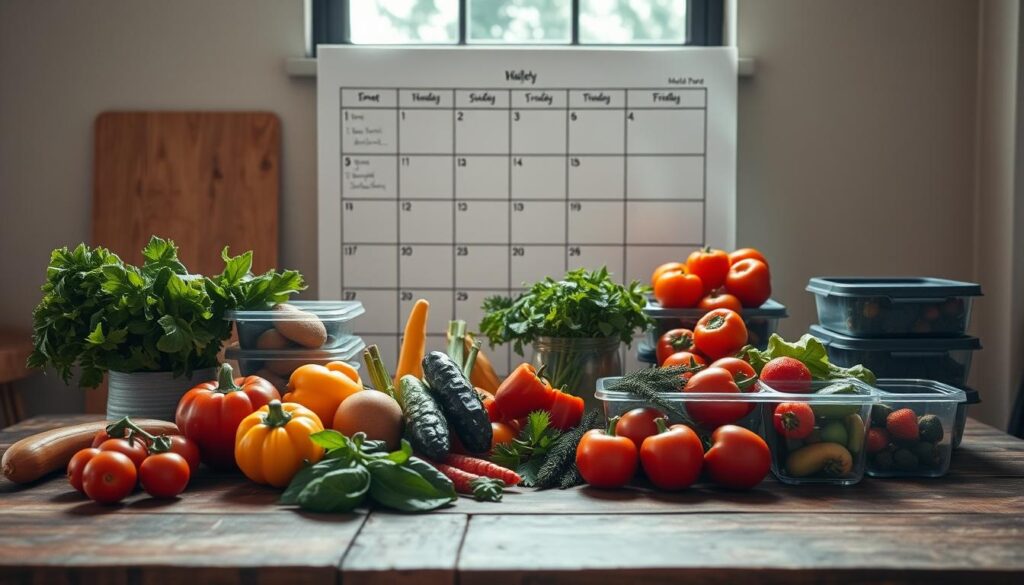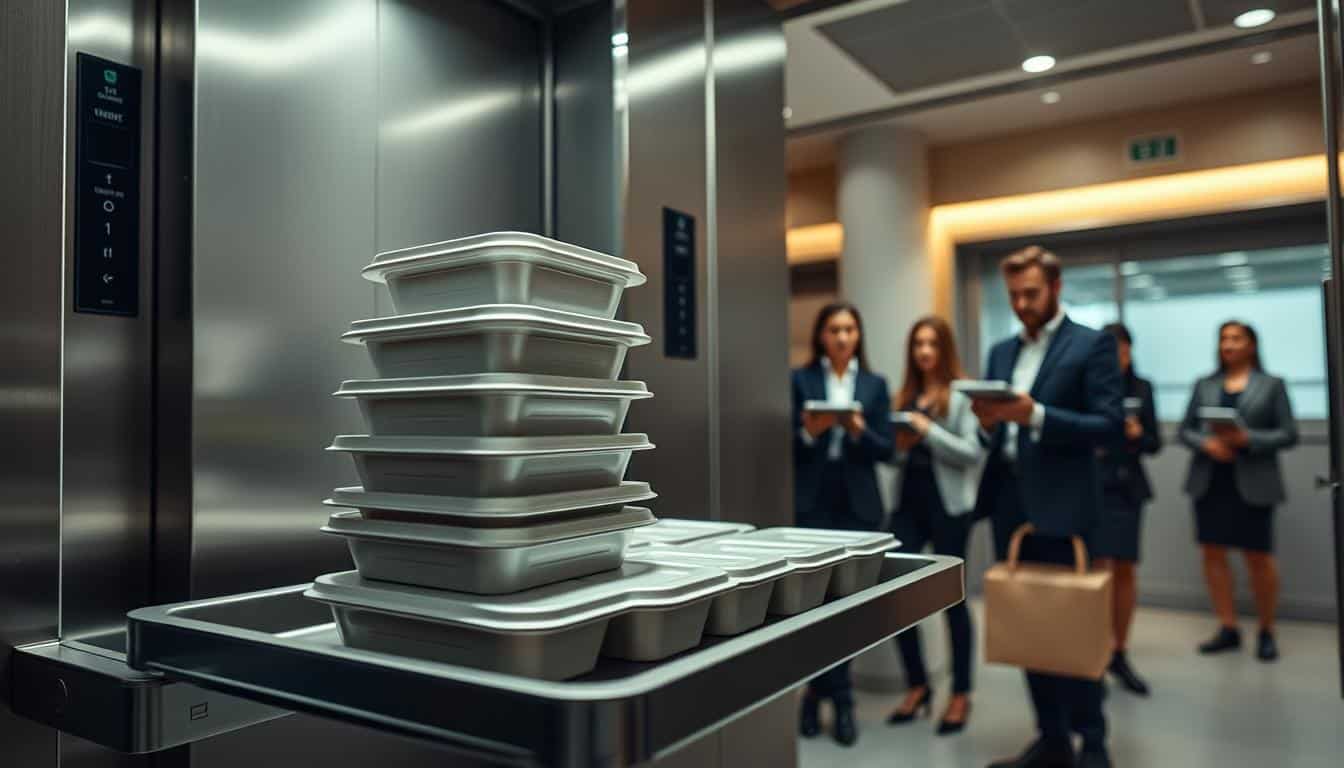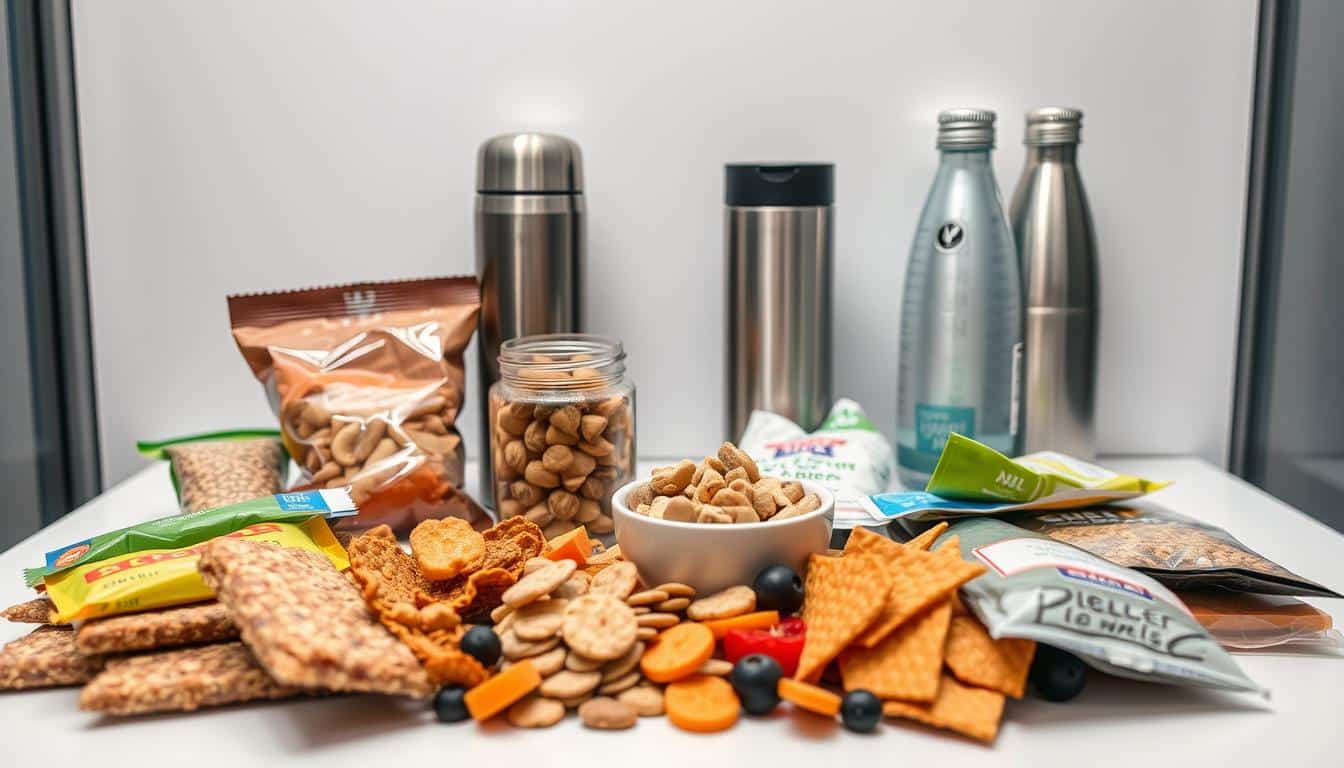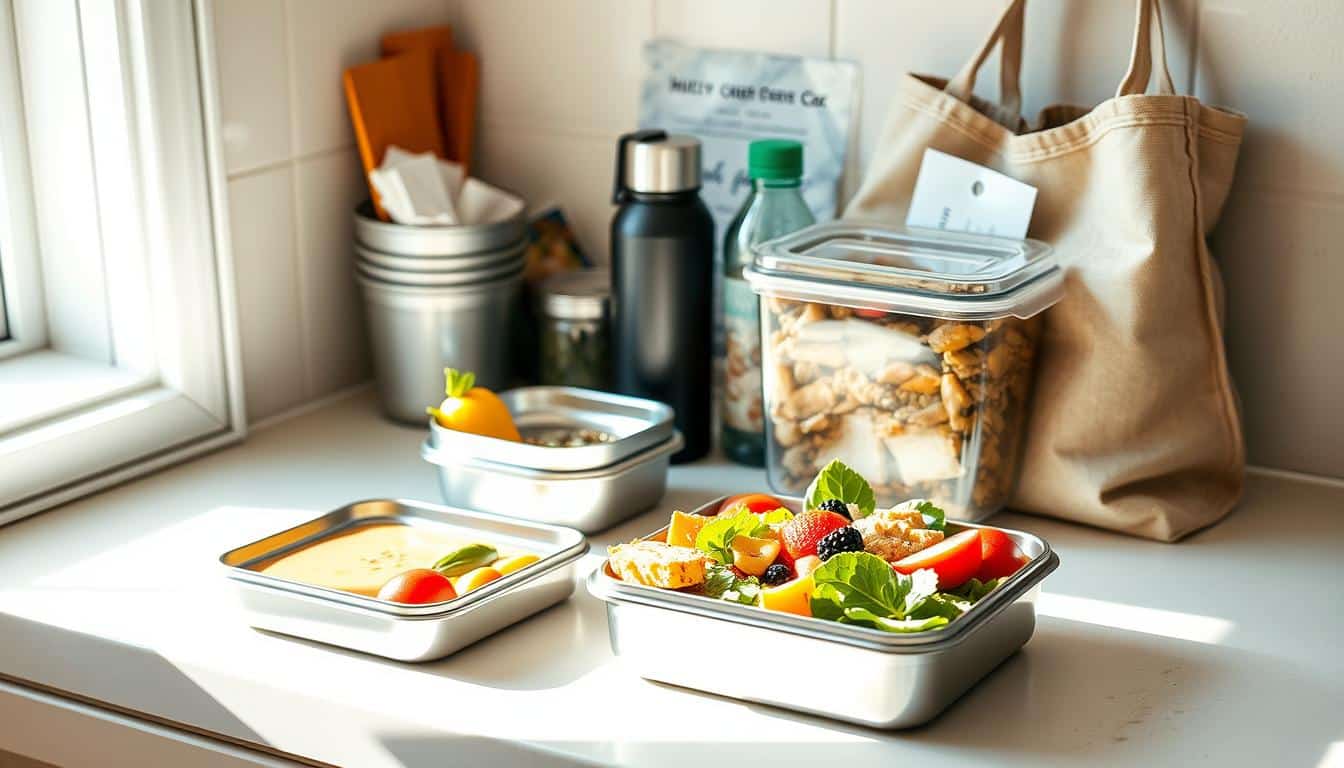In our fast world, we can’t overlook the importance of elevator-safe meal planning. Balancing busy lives makes it tough to eat well. That’s why planning your meals for work is key. By preparing ahead, you save time and avoid stress from last-minute decisions.
Meal planning is more than just eating healthy. It boosts your productivity too. With good plans, you feel ready. Both in body and mind, for a healthier day at work.
The Importance of Meal Planning for Workplace Health
Meal planning is key for better health at work. It helps employees eat balanced meals and stay well. With a plan, eating healthy at work becomes easy, lowering the risk of heart disease and obesity. This boosts energy, mood, and productivity during the workday.
Companies can help by promoting good eating habits. They can offer places to prepare meals and take breaks. This support makes it easy for staff to eat well during work. A workplace that values healthy eating can improve how individuals and teams perform.
Understanding Elevator-Safe Meals
Elevator-safe meals are a smart choice for busy people. They’re made to carry around and easy to eat anywhere. This makes them great for workers who need quick meals during a busy day. You can have a nutritious meal without needing a fridge or spending time on preparation.
Consider salads in jars, wraps with whole grain tortillas, and snacks like nuts or granola bars. These foods are healthy and easy to clean up after. They’re perfect for the office. With some planning, eating well and staying energized is easy, even on your busiest days.
Elevator-Safe Meal Planning Tips for Work
Picking the right containers and food for meal prep is key, especially when you have to use an elevator at work. Good meal prep containers help keep your meals organized. They make sure your food stays fresh. It’s smart to use containers that are safe for both the microwave and freezer. This makes things easier and keeps your food good for longer.
Choosing the Right Containers
Meal prep containers that control portions are best. They keep your meals in order and reduce waste. Look for containers that stack well and won’t leak. These containers are perfect for packing work lunches and dinners quickly.
Opting for Non-Perishable Items
Adding non-perishable foods to your meal prep is a smart move. Choose items like canned beans, whole grain crackers, and nuts. They last a long time without needing to be in the fridge. This helps keep your meal prep healthy even on busy days. It’s a great fit for the modern workplace, offering easy, healthy options.
Balancing Nutrition and Convenience
It’s important to find a balance between healthy eating and ease at work. Including lots of fruits and veggies during the day makes meals more enjoyable. They’re full of good stuff like vitamins but don’t have a lot of calories. This makes them perfect for eating well. There are easy ways for workers to add these healthy foods into their day.
Incorporating Fruits and Vegetables
Adding fruits and veggies at work is easy and tasty. Here are some ideas:
- Salads with different greens, colorful veggies, and various toppings.
- Smoothies made from mixed fruits and greens for a quick drink.
- Snack packs of chopped fruits and veggies for eating on the move.
These options help you eat well and stay happy and healthy all day.
Selecting Lean Proteins
Choosing lean proteins is key for good nutrition at work. They keep your energy up and help your muscles recover. For your meals, try these:
- Grilled chicken or turkey for high-quality protein.
- Fish like salmon or tuna, great for omega-3s.
- Plant proteins such as lentils, beans, and chickpeas for those who don’t eat meat.
Making these protein choices ahead of time means meals are both nutritious and convenient. This helps employees eat well without sacrificing time or taste.
Simple and Quick Meal Ideas
Meals during a busy week can be simple. With quick meal prep ideas and efficient techniques, tasty and nutritious meals come easy. Go-to choices often include recipes with fewer ingredients. Here, we share easy recipes ideal for work lunches that don’t eat up your time.
Easy to Prepare Recipes
Choose recipes that are simple yet satisfying. Here are some top picks:
- Quinoa salads, packed with vegetables and proteins, ideal for a filling lunch.
- Overnight oats, customizable with various toppings, for a nutritious breakfast or snack.
- Veggie wraps, with whole grain tortillas filled with your favorite veggies and dips.
These recipes are not only tasty but support healthy eating at work without much cooking.
Batch Cooking Techniques
Batch cooking means making large amounts of food at once. Cook grains like brown rice or quinoa, proteins such as chicken or beans, and various vegetables. This approach offers flexibility and exciting lunch options throughout the week.
By batch cooking, you save time and make healthier lunch choices during weekdays. It’s a great way to make work lunches better.
Meal Prepping for Busy Weeks
Meal prep is a big help for those with tight schedules. Planning your meals each week makes it easier to eat well and stay stress-free. With a good plan, you can include different foods, making shopping simple and cutting down on waste.
Creating a Weekly Meal Plan
Having a plan for the week helps you cook efficiently. By knowing what to cook each day, you save time and money. Here’s how to make a good meal plan:
- Choose a day to outline your meal plan for the week.
- Incorporate different food groups to maintain nutritional balance.
- Prepare a shopping list based on the meals planned.
- Schedule cooking sessions to ensure meals are ready when needed.
Storing Meals Properly
Storing meals the right way is key to keeping them fresh. Using airtight containers helps protect them from air and spoilage. Here are some storage tips:
- Label containers with the meal type and preparation date.
- Organize meals by category within the refrigerator.
- Store meals at appropriate temperatures to enhance safety and quality.
- Defrost or heat meals properly before consumption.

Healthy Snack Options for Work
Snacks that are good for you are key to staying energized and focused at work. Planning ahead lets you dodge junk food cravings. Everyone can enjoy snacks that are easy to make, tasty, and healthy. Below, find tips for making quick snacks you can just grab and ones that are full of nutrients.
Prepping Grab-and-Go Snacks
Having simple snacks on hand means you’ll always have good food choices. Here are some yummy options:
- Mixed nuts: They offer a healthy mix of fats and protein.
- Yogurt parfaits: With yogurt, berries, and granola, they’re a delightful snack.
- Veggie sticks: Carrots, celery, and bell peppers with hummus or guacamole are great for an energy lift.
Packing Nutritious Treats
It’s important to choose snacks with healthy ingredients for work. Here are some favorites:
- Whole grain bars: They give you energy without too much sugar.
- Fruit smoothies: They’re easy to make ahead and are full of vitamins.
- Energy balls: A mix of oats, nut butter, and dried fruits for a quick snack.
Getting others to help make snacks can create a fun community vibe. Including family or coworkers can turn healthy snacking into a shared, enjoyable habit.
Embracing Flexibility in Meal Choices
Flexible meal planning is key to a good food relationship, especially at work. Employees have different schedules and likes throughout the week. Being flexible with meals lets people meet their needs and make healthy choices.
Trying new ingredients can make meals versatile and adaptable. You might use whole grains or greens as a base. Then add proteins, vegetables, and tasty dressings. This not only makes eating fun but also promotes lasting meal habits.
Flexibility in meals sparks creativity in cooking. Workers can explore new recipes or tweak their favorites to fit their tastes or dietary needs. This boosts happiness and encourages a healthy way of life.
Meals like salads, wraps, or grain bowls add to meal planning’s flexibility. These options keep meals interesting and stop them from becoming boring. This way, everyone can enjoy looking forward to their meals daily.
Conclusion
To sum it up, starting your journey with good meal planning is key to better health at work. Spending a bit of time on safe, easy-to-carry meals can make a big difference. It helps you eat better and stay sharp and efficient on the job.
Using simple recipes, wise ways to keep food fresh, and lots of healthy ingredients can make this change easy. Turning meal prep from a chore into a quick task means more focus, energy, and work productivity. It shows how important eating right is.
In the end, getting creative and organized lets anyone reap the benefits of good meals. Adopting these habits not only keeps us healthy but also makes work more enjoyable. It proves healthy eating can be a reality for all of us at work.



